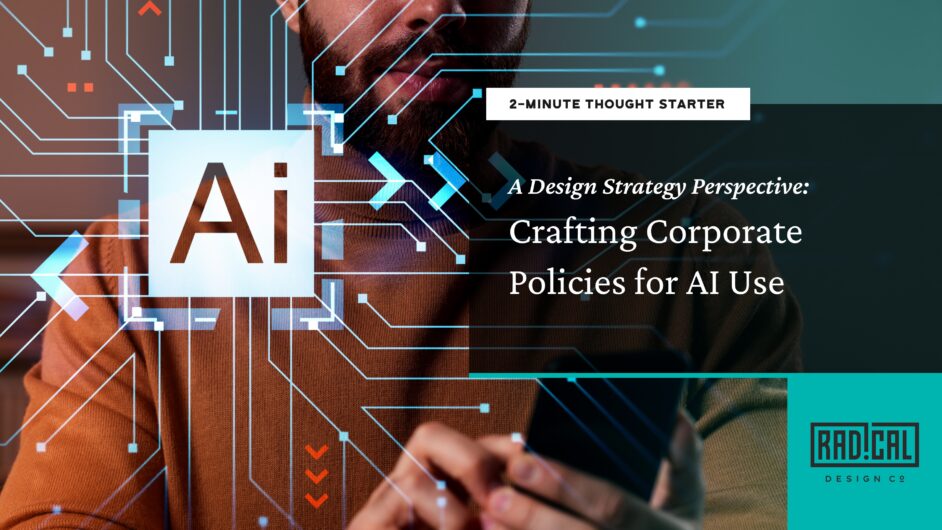A Design Strategy Perspective: Crafting Corporate Policies for AI Use
Explore the art of crafting AI corporate policies from a design strategy lens. Dive deep into AI tool landscapes, balance innovation with ethics, and ensure data integrity. Learn to merge tech prowess with organizational ethos for a responsible AI-driven future.

In the dynamic digital era, AI encompasses more than just the standard mental models often associated with platforms like ChatGPT or Google Bard. These represent just a segment of the broader AI spectrum. As businesses harness many AI tools, their focus must be twofold: leveraging them for efficiency and empowering the workforce to produce unparalleled work.
However, the advent of AI has challenges. When AI’s power masks genuine human effort or an employee’s unsanctioned use puts sensitive data at risk, the necessity for robust corporate policies becomes evident. A one-size-fits-all policy may be an initial step. Still, the multifaceted nature of AI requires adaptive, context-specific guidelines that ensure the integrity of outputs and protect critical data.
It’s an evolving endeavor, keeping pace with technological progress and business growth. Leveraging a design strategy perspective ensures that policies remain holistic, user-centric, and adept at tapping into AI’s potential while staying alert to its pitfalls. Let’s look at how companies can draft thoughtful and engaging policies to guide AI tool usage.
-
Understand the Landscape of AI Tools
A comprehensive policy starts with a clear understanding of the AI landscape. Recognizing the capabilities and limitations of each AI type shapes informed decisions and facilitates strategic deployment in the workspace.
- Textual AIs (e.g., ChatGPT) Streamline content creation, provide swift research, and interpret data.
- Visual AIs (e.g., MidJourney & Adobe Firefly) Generate compelling visuals, enhance design tasks, or boost multimedia content quality.
- Analytical AIs (e.g., Tableau’s AI features) Dive deep into large datasets, unearth patterns, and drive actionable business insights.
- Automation AIs (e.g., UiPath for Robotic Process Automation) Take over repetitive tasks, efficiently schedule meetings, or oversee project workflows.
-
Emphasizing Benefits and Addressing Concerns
The strategic incorporation of AI tools into corporate frameworks signifies more than just a technological leap; it represents a profound shift in operational dynamics. When AI handles the automation of mundane tasks, businesses can realize substantial time and cost savings. Moreover, these AI tools’ algorithms are designed to process and analyze vast datasets, providing teams with unique insights that would be nearly impossible to glean manually. Such data-driven findings, combined with AI’s capability to foster creativity, can drive forward novel solutions and innovative perspectives, truly redefining how companies approach problem-solving. However, the concerns related to AI use are just as deep and include things like:
- Data Integrity The honesty, freshness, and trustworthiness of the data AI utilizes can often come under scrutiny.
- Sourcing and Authenticity Distinguishing if an AI tool’s data is current or if it originates from credible sources remains a significant challenge.
- Lack of Verification Mechanisms Traditional methods for validating data integrity and its sources might not be suitable for AI-generated outputs.
It’s vital to strike a balance. Recognizing AI’s unparalleled advantages is crucial, but being cautious and addressing potential pitfalls is equally imperative. As businesses venture deeper into AI, a well-informed policy that celebrates AI’s capabilities and respects its limitations will be essential.
-
Establishing a Design Strategy Framework for Ethical AI Innovation and Control
Crafting effective AI policies requires a merger of ethical understanding with design strategy. It’s not just about limiting or controlling AI’s role but about nurturing a culture where AI is used responsibly, transparently, and ethically while promoting innovation.
This framework’s heart lies in the commitment to intertwining ethical guidelines with core company values, ensuring that while AI is a tool for efficiency and innovation, it doesn’t operate in a vacuum but aligns with the broader organizational ethos. Every stakeholder should be well-acquainted with how AI influences their daily operations and the ethical parameters within which it operates. Critical considerations for this integrated framework include:
- Transparency It’s important to consider criteria for labeling and appropriately attributing AI-generated outputs so that all content consumers understand its origins and potential biases.
- Training Just as technology evolves, so should our understanding of it. Regular educational sessions can keep the workforce updated on AI’s ever-expanding capabilities and remind them of the ethical considerations surrounding its use.
- Ethical Checks It’s not enough to have guidelines; they must be actionable. Policies should include mechanisms to actively thwart biased outputs, guarantee fairness in AI’s operations, and ensure that AI tools remain inclusive.
However, while ensuring ethical use is crucial, we mustn’t stifle innovation. AI holds immense potential, and to harness it, companies need to provide an environment where experimentation is encouraged yet controlled. This is where design strategy comes into play. Rather than a restrictive set of rules, think of AI policy as a well-crafted user experience that adapts to the needs of its users. To achieve this:
- Sandbox Environments Create spaces where employees can experiment with AI tools without the fear of jeopardizing sensitive data. This not only promotes innovation but also builds trust.
- Tiered Access Models Recognize that not all roles have the exact needs. You can maintain security without hampering creativity by providing different access levels based on roles and responsibilities.
In this reimagined policy framework, businesses can balance AI-driven innovation, data security, and ethical considerations, ensuring that AI responsibly serves the company and its stakeholders.
More Thought Starters

Thought Starters
The Great AI Debate: Be AI-Empowered, Not AI-Overpowered!

Thought Starters
Strategize, Don’t Just Dive in: The Metaverse Conundrum

Thought Starters